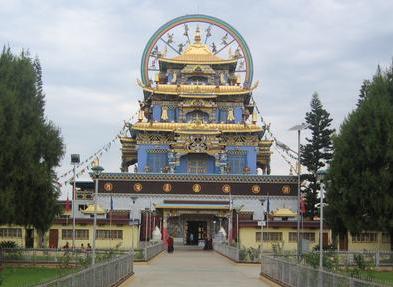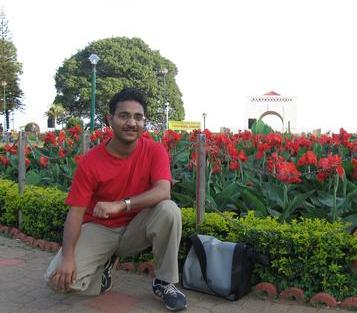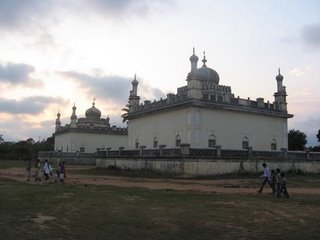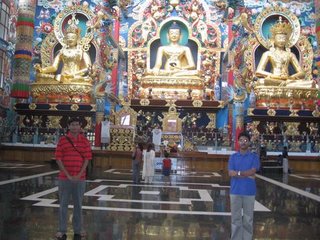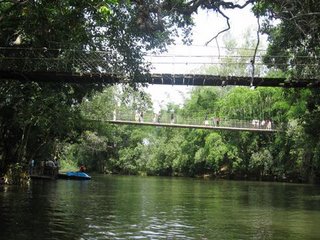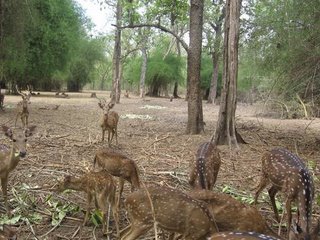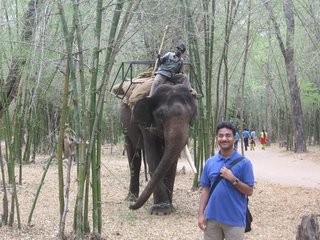Koduchadri is accessible from nearby town of Kollur (Karnataka) by a jeep-road (15 km), though the trekking option is more popular and I with my pal undertook it.
KOLLUR - The base-town for the Trek
Kollur is a religious town some 2.5 hours away from Udupi town. Udupi is a prominent town on NH-17 in the stretch between Mangalore City and Karwad. Buses are destined to Kollur every 15 min from the private (SBI) Bus Stand in Mangalore (134 kms, 4 hrs, Rs 67). Thus, we arrived at Kollur at noon and headed for the main Mookhambikay Temple (Closed between: 1:30 – 3 pm). Mythologically, the Goddess had killed the Mokhasur demon and hence the name. As all the temples set up by sage Shankaracharya have the priests of his sect, hence the Malayali influence is noticeable.
Karikatta - The Trek begins from here...
The trekking starts from a point or a bent in the road called Karikatta - 20 kms from Kollur. From Kollur, the buses to Karikatta leave around 2, 2:30 and 3 pm. Hence, by 2 pm, we had seen Mookhambikay Temple, done Lunch and had replenished all stocks and viands – water, fruits, mosquito repellants, batteries etc. as the journey onwards were to be a solitary one. We boarded the bus and reached Karikatta at 2:45 pm. This point is unmarked and uninhabited and hence very difficult to spot for the uninitiated, but for the bus-conductors. Fortunately, two more Malyali pals (from the Kerala state) also got down from the bus and four of us then entered the jungle trail. It is a dense Mookhambikay Wildlife Sanctuary through which this jeep-track winds its way for 4 kms.
Santosh Restaurant - is halfway, and climb begins from here...
At the end of this jeep-track, there is a lone restaurant, quite a landmark for this place called Santosh hotel. We had tea here and refilled our water-bottles from the rivulet.Now began a rather steep climb for another 4 kms. It was the most exhausting thing I had ever undertaken, and perhaps in a way, my ignorance about this sheer climb was bliss or else I might have baulked earlier. While the beaten path was clearly visible, it was narrow and riddled with slippery stones, broken trees and fern-leaves which may cause skin-rash. During rains, it is muddy and full of leeches as well, but not now. Still, we had packed some salt with us. The route went through inspiring forested and mountainous landscapes, dense jungles, open grasslands and hair-raising precipices, while the sun fumed on our heads. Managing a very sporty pace, we reached temple by 5 pm. Eight kms in 2 hours!
KODACHADRI - The Temple
The next morning was the most auspicious day of Shiv Ratri and the entire temple complex was cleaned and festooned with banana leaves. We rose early to capture the sun-rise in our cameras and hearts. How the sunlight dispels the mist and how pristine is the valley that lies further! A quick breakfast and we descended back from Koduchadri the same way, bidding adieu to our Malyali pals. The return journey is more treacherous as one has the sight of ruthless fall over the precipices as a frequent companion. A small slip at the wrong place and Mohit was an adventurous and a bright young man, beloved by all. The descent too took 4 hours (the same time as climb)!! Throughout the descent, groups of local boys and girls dressed in their best clothes were making for the temple in the morning and a few jeeps also came our way. Today was the restaurant’s day of the year.
Return Journey
We soon reached Kollur and then caught a bus for Udupi town where we lunched and headed for the Malpe beach. Along with Ullal / Summer Sands Beach in Mangalore city, this is the beach with the most facilities in all of South Karnataka with a youthful crowd from nearby Manipal Medical College and Surathkal REC to boot! And we were soon kissing the surf, only to dry the clothes lying on the bench for another 1 hour. The island of St. Mary is near and the boat for it can be boarded from the nearby docks (1.5 km) but unfortunately as we realized, only before 4:30 pm. So we returned for the Mangalore city
